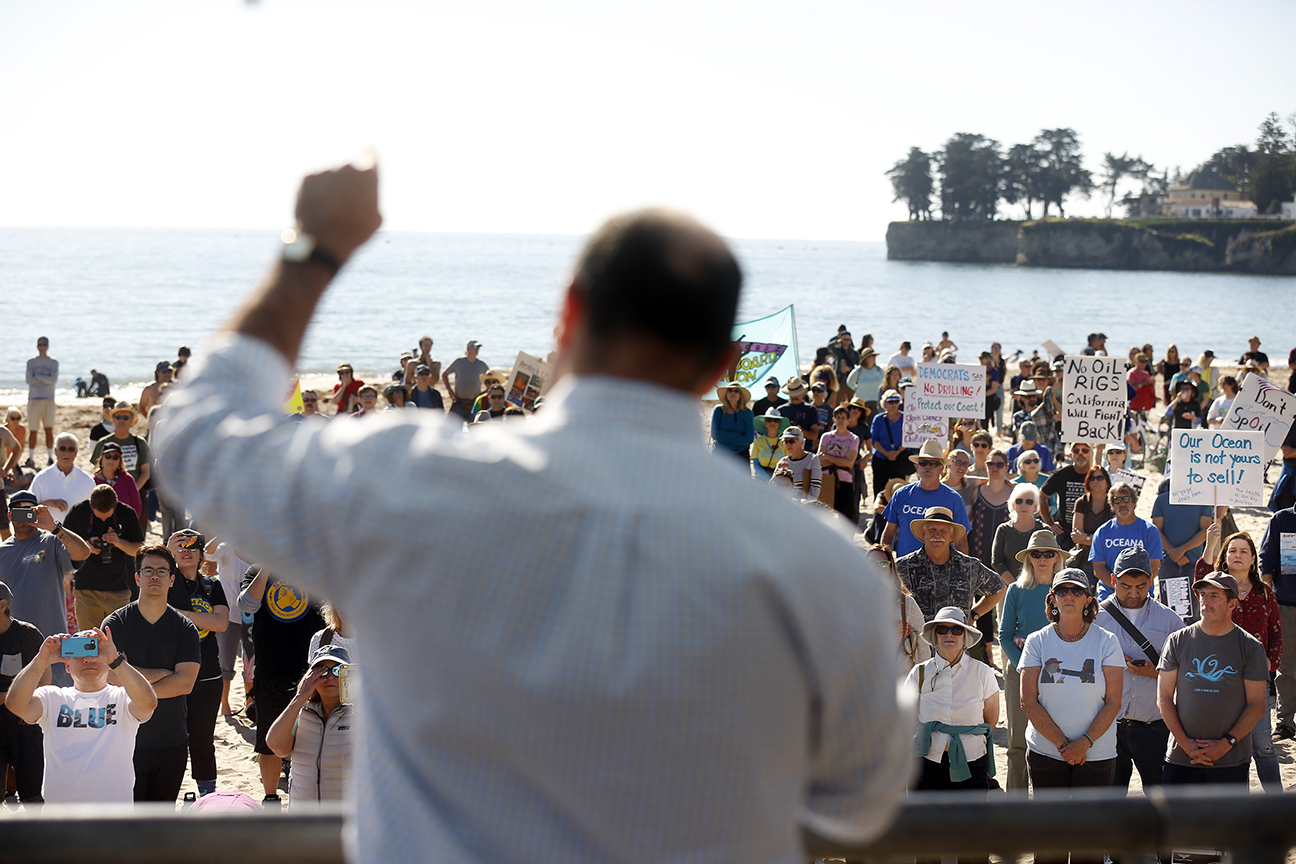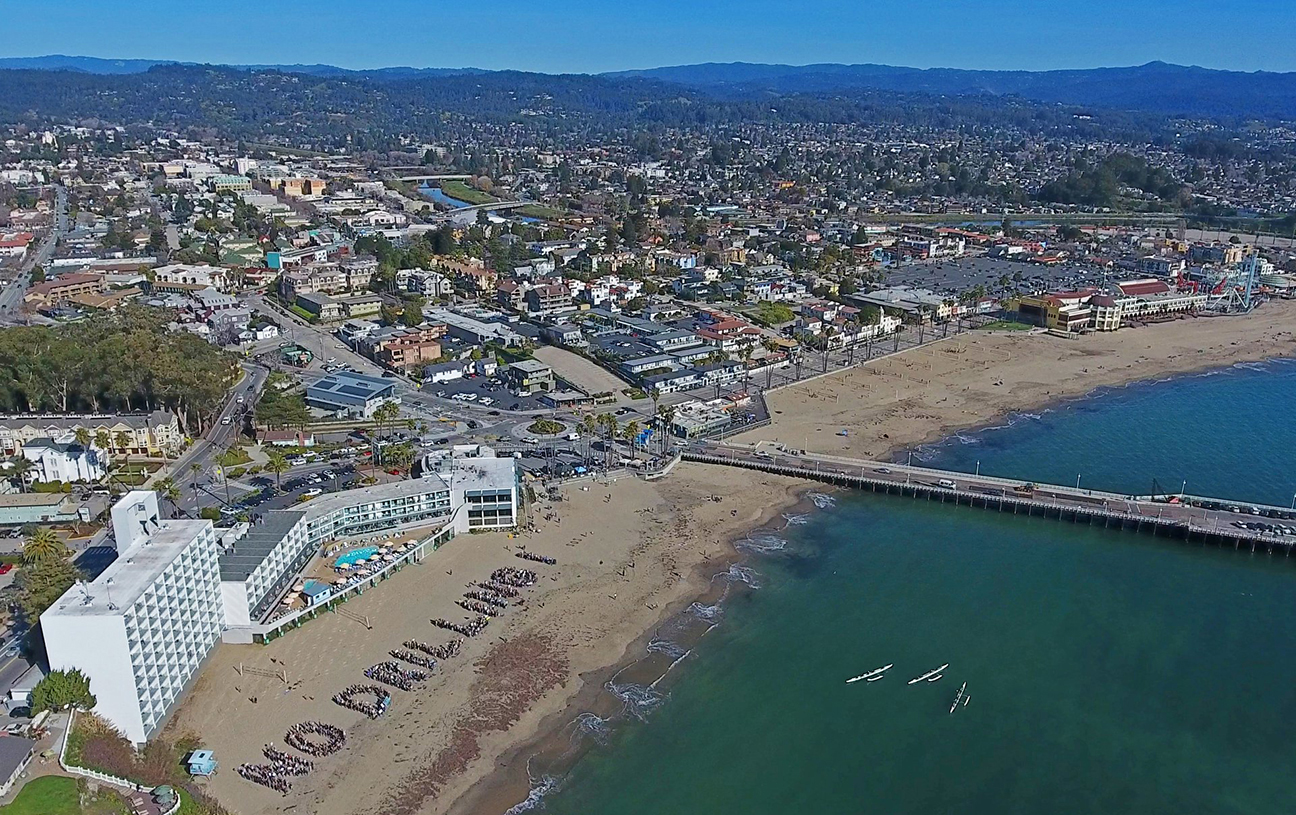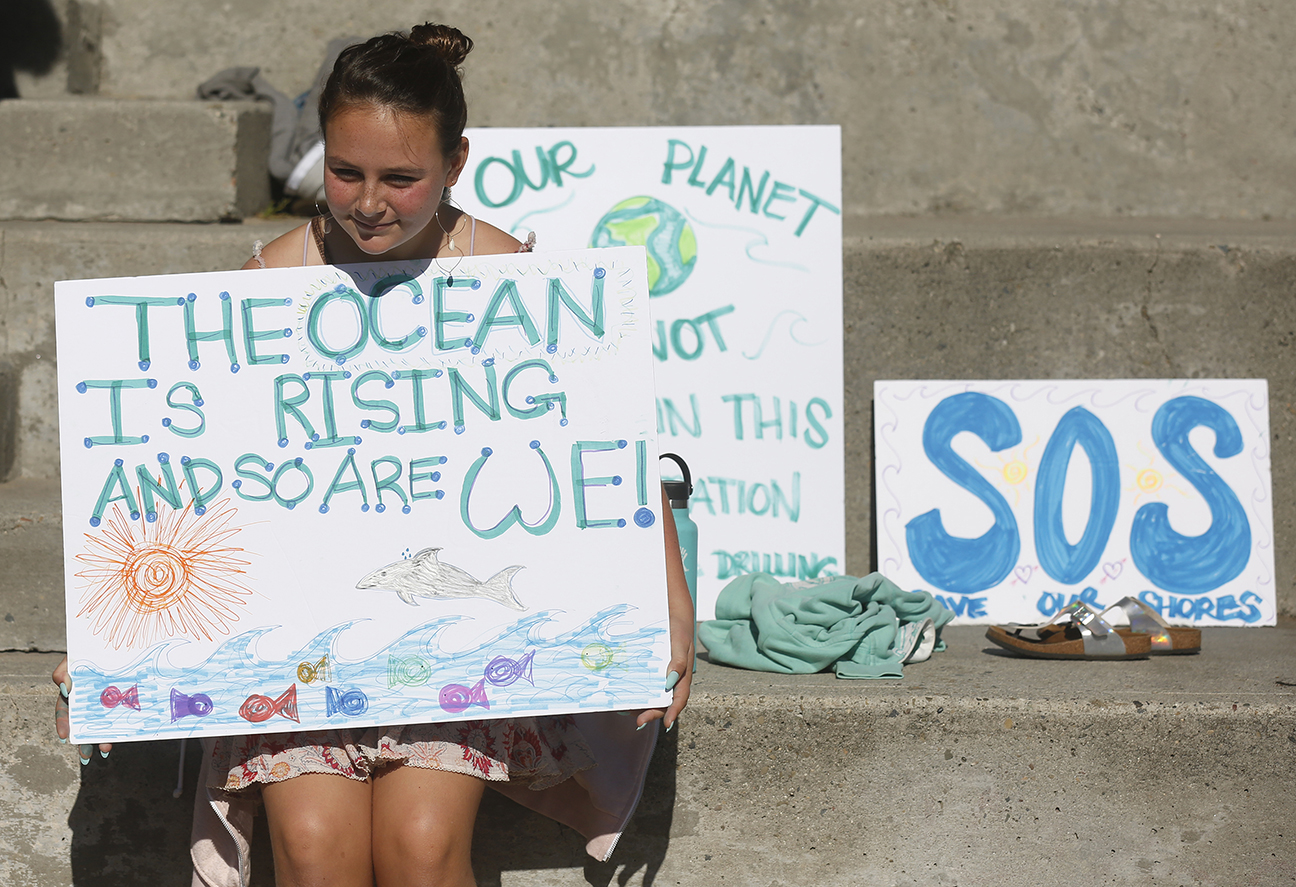In Santa Cruz, marchers protest the possible return of offshore drilling. | David Royal
By Kathryn McKenzie
Photographs by David Royal
Dying seabirds coated with black tar, seals and dolphins dying by the thousands, and thick oil sludge smothering previously beautiful beaches were the images that launched a generation of young environmentalists and also changed U.S. environmental policy for the better. The horrendous Union Oil blowout off the coast of Santa Barbara in 1969 spurred President Richard M. Nixon to create federal safeguards to keep it from happening again.
For some decades, it seemed as though such tragedies couldn’t touch the Monterey Bay, thanks to the wide variety of protections that were hammered into place over the years, culminating in the 1992 establishment of the Monterey Bay National Marine Sanctuary — the nation’s largest marine sanctuary, sheltering thousands of species that live in this unique ocean environment.
But the specter of Santa Barbara is now rearing its head with the Trump administration’s proposal to clear the way for offshore oil and gas drilling on all the nation’s coasts. The draft 2019-2024 offshore leasing plan, released Jan. 4, would allow drilling in federal waters in all U.S. oceans.
Local environmentalists and officials are concerned by the plan and are urging anyone who cares about the coast to speak up — and to do it quickly, since the public commentary period ends on March 9.
Despite pleas from officials to hold multiple meetings that will allow more residents to participate, only one hearing by the federal Bureau of Ocean Energy Management will be held in California, coming up February 8 in Sacramento.
“It’s important to be loud now and to really push back,” said Assemblyman Mark Stone, whose district includes parts of Santa Cruz, Monterey, and Santa Clara counties. Pushing back includes attending rallies and marches, such as the one Stone spoke at Saturday, Feb. 3, in Santa Cruz, along with a variety of other state and local officials. “The louder we are, the louder the message is to the oil companies: It’s not worth their time or money, go look elsewhere.”

Almost a thousand people turned out for the rally on Cowell Beach, where supporters stood to be part of a giant NO DRILLING message on the beach. The Santa Cruz event, organized by a coalition of organizations that included Save Our Shores and Oceana Monterey, was one of seven held in the state that day.
It will be a week of continuing activism and attention to the issue, according to Miyoko Sakashita, who will be involved in a Californians Against Offshore Drilling rally on the steps of the state capitol building prior to the BOEM meeting.
“We’re coming to Sacramento to reject a plan that will cause oil spills and climate chaos,” said Sakashita, ocean program director with the Oakland-based Center for Biological Diversity. “Our beautiful beaches and imperiled marine wildlife face grave threats from offshore oil development, whether wells are drilled in the Pacific or the Arctic.”

Even though it’s unlikely that drilling would ever be allowed in the Monterey Bay National Marine Sanctuary, it is certain that drilling anywhere along the Pacific Coast has the potential to do harm here, said Sakashita.
“Just look at Louisiana,” said Sakashita, referring to BP’s Deepwater Horizon disaster that spilled 210 million gallons of oil into the Gulf of Mexico in 2012. “On the beaches of Florida, oil balls have been washing up for years.” Studies show that toxic fallout from the largest marine oil spill in history is still continuing, causing infant dolphin death at six times the normal rate in the gulf, and causing heart malformations in tuna and other ocean fish.
Oil spills spread — that’s just their nature — and there’s no realistic way to keep a marine spill contained. More oil drilling leases mean the potential for greater numbers of spills, says Sakashita. In addition, such a plan will add to climate change, she said, if all the recoverable oil and gas in the planning area is consumed. “It’s one of the largest carbon polluting proposals ever,” said Yamashita.
Just the act of oil exploration has the potential to do harm to wildlife along the coast, said Brandon Southall, president of Southall Environmental Associates in Santa Cruz. SEA studies a variety of environmental marine issues, including the effect of human-generated noise on marine life such as whales, seals and fish.
“These animals are very dependent on sound — they use sound like we use light,” said Southall. “They’re acoustic creatures and they’re very attuned to sound” for everything from keeping track of their young to finding food. Acoustic studies to find drilling sites use loud low-frequency sound which has the potential to disturb, stress, or drive away wildlife, he said.
There’s also the thought that adding one more stressor to the ocean environment could be a crucial tipping point from which there is no return, as Carmel Valley environmental activist and Middlebury Institute of International Studies instructor Marie Butcher points out.
“What is important is how critical the health of the ocean is to everything else, and there are so many other things threatening the oceans,” said Butcher, who teaches a class on climate change at MIIS. Adding oil rigs on top of such concerns as plastic pollution and ocean acidification is a bad idea, she said.
“It’s important to be loud now and to really push back. The louder we are, the louder the message is to the oil companies: It’s not worth their time or money, go look elsewhere.” Assemblyman Mark Stone
It’s not just pure environmentalists or liberals or even Democrats who are opposed to opening up oil and gas drilling in U.S. oceans. In fact, the proposal is encountering bipartisan opposition across the country, with governors of almost every coastal state speaking out against it. It’s also coming at a time in history when the United States is exporting oil in record amounts, leaving many to scratch their heads over why more offshore drilling is even necessary.
“There have been rallies happening all across the country,” said Sakashita. “Communities across the country are angry, and it’s all different groups.” Monterey and Santa Cruz counties have both passed resolutions of opposition, and so have the cities of Monterey, Capitola, Watsonville, Santa Cruz and Marina.
The issue is also not purely environmental, but one that could affect tourism along many coasts, and not just between Pescadero and Big Sur. After all, it’s the beauty of the Monterey Bay that brings in the bucks.
“Tourism and recreation industries alone support more than 26,000 jobs and generate more than $2.3 billion in Monterey County annually,” wrote Jody Hansen, president and CEO of the Monterey Peninsula Chamber of Commerce, in a Dec. 19 letter opposing the plan. “New offshore oil and gas drilling and exploration puts these resources at risk.”
And even though the Monterey Bay is federally protected, there is a feeling among environmentalists that anything can happen where the Trump administration is concerned. There seem to be sufficient safeguards in place, said Save Our Shores executive director Katherine O’Dea, but “the threat is really there…this administration doesn’t play by common-sense rules. To not be concerned seems somewhat naïve. We just don’t know what they’re capable of.”
Butcher said that this is one issue for which public outcry is called for: “I’m thankful that we have a lot of protections with the Monterey Bay sanctuary, but we still need to put up a good fight, contribute to the public comments and to show up at the meetings.”

Mark Stone is cautiously optimistic that Northern and Central California are safe from drilling, due to the fact that onshore infrastructure to handle oil transmission just isn’t there. Any company that tried to get such infrastructure approved would be hit with a firestorm of public wrath. In addition, he said, building infrastructure would have to be approved by the California Coastal Commission and the state Land Use Commission.
However, said Stone, “The risk is real.” Ripples from additional leases in Southern California, such as more oil spills and disruption to the marine environment, could reach the Central Coast — and increased oil tanker traffic could also impact the Monterey Bay sanctuary.
Even with safeguards for the marine environment in place, people need to speak up, write letters to their elected officials, and provide public comment to the BOEM online, Stone said. All of that will let oil companies know that Californians are prepared to fight against any offshore drilling plans.
Sakashita concurs, saying there’s much at stake here. “Offshore drilling is a double whammy. First it threatens marine wildlife and coastal communities with oil spills. Then these decades-long leases delay our transition to clean energy, and heat up our atmosphere and oceans. We simply don’t need the oil under our oceans or the extreme risks of drilling for it.”
“The BP spill — can you imagine that happening here?” said Stone. “Only here, it would be a whole lot harder to clean up.”
GET INVOLVED |
Monterey Bay Aquarium’s Action Alert
Offers information on adding comments to the federal register regarding the offshore drilling draft plan.
Save Our Shores
Tips for being heard.
Have something to say about this story? Send us a letter.